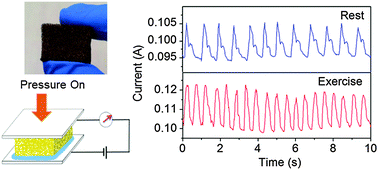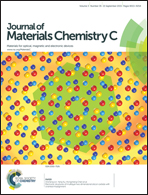A flexible high-sensitivity piezoresistive sensor comprising a Au nanoribbon-coated polymer sponge†
Abstract
Development of pressure sensors which display high sensitivity, and are flexible, inexpensive, and easy to manufacture has drawn significant interest due to their diverse applications such as tactile skin sensors (e.g. “electronic skin”), pulse detectors, speech recognition elements, and others. While varied technologies and molecular constructs have been demonstrated for pressure sensing, considerable conceptual and technical challenges still hamper broad implementation of many such systems. A novel flexible piezoresistive sensor comprising a conductive Au-coated elastomeric polymer sponge is presented. The piezoresistive sponge is prepared through a simple chemical route in which Au nanoribbons are spontaneously grown upon an amine-functionalized polyurethane framework. The Au nanoribbon layer coats the internal surfaces within the polymer pore network, resulting in electrical current modulation upon pressure application/release through changes in the overall contact areas between the conductive surfaces. The Au-polyurethane piezoresistive sensor exhibits excellent functionalities, including enhanced sensitivity, low detection threshold, high fidelity, and physical stability. Application of the sensor is demonstrated for high resolution monitoring of wrist arterial pulses.


 Please wait while we load your content...
Please wait while we load your content...